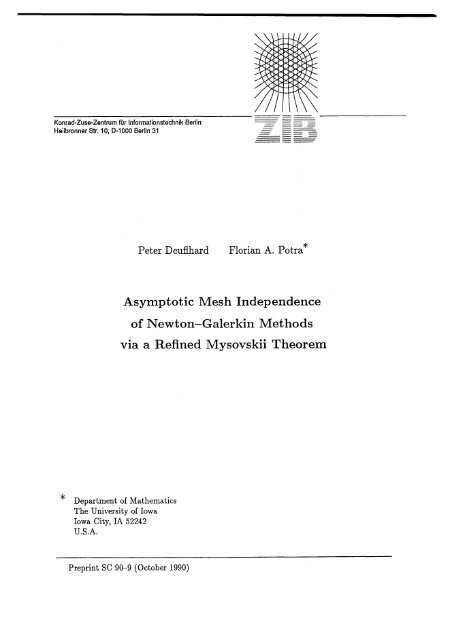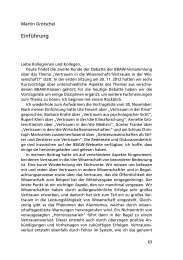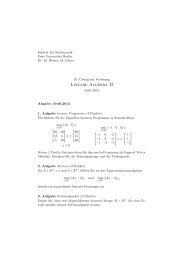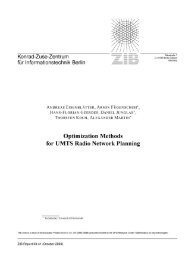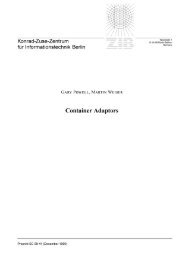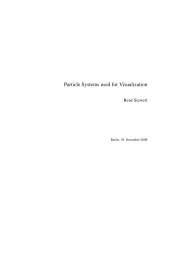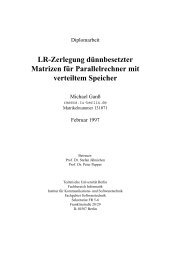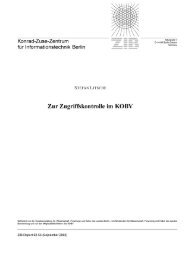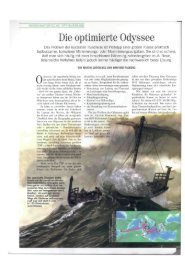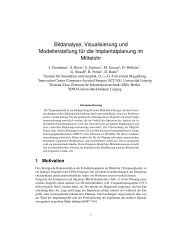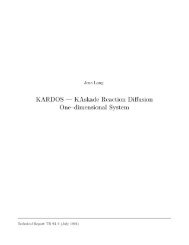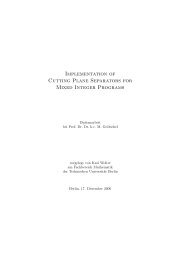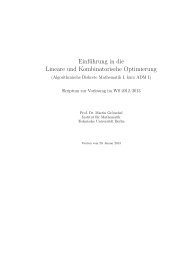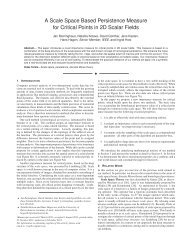SC-90-09.pdf - ZIB
SC-90-09.pdf - ZIB
SC-90-09.pdf - ZIB
You also want an ePaper? Increase the reach of your titles
YUMPU automatically turns print PDFs into web optimized ePapers that Google loves.
Konrad-Zuse-Zentrum für Informationstechnik Berlin<br />
Heilbronner Str. 10, D-1000 Berlin 31<br />
Peter Deuühard<br />
Florian A. Potra<br />
Asymptotic Mesh Independence<br />
of Newton-Galerkin Methods<br />
via a Refined Mysovskii Theorem<br />
Department of Mathematics<br />
The University of Iowa<br />
Iowa City, IA 52242<br />
U.S.A.<br />
Preprint <strong>SC</strong> <strong>90</strong>-9 (October 19<strong>90</strong>)
Herausgegeben vom<br />
Konrad-Zuse-Zentrum für Informationstechnik Berlin<br />
Heilbronner Str. 10<br />
1000 Berlin 31<br />
Verantwortlich: Dr. Klaus Andre<br />
Umschlagsatz und Druck: Rabe KG Buch-und Offsetdruck Berlin<br />
ISSN 0933-7911
The authors wish to thank Erlinda Cadano-Körnig for her quick and careful<br />
T£X-typing of this manuscript.
0. Introduction<br />
Mesh independence of Newton's method means that Newton's method applied<br />
to a family of finite dimensional discretizations of a Banach space nonlinear operator<br />
equation behaves essentially the same for all sufficiently fine discretizations.<br />
This fact has been frequently observed and even used in designing efficient mesh<br />
refinement strategies for certain classes of nonlinear equations (e.g. [1], [9]).<br />
In order to explain these observations, a mesh independence principle for Newton's<br />
method has been proved in [2] for general families of discretizations that<br />
are bounded, stable, consistent and Lipschitz uniform. The last property means<br />
that the Frechet derivatives of the finite dimensional operators are Lipschitz continuous<br />
with a Lipschitz constant that is independent of the mesh size. Such<br />
a uniform Lipschitz condition may be hard to verify for a number of operator<br />
equations (such as the biharmonic equation). In the present paper we do not require<br />
this property as an axiom, but obtain it asymptotically in a rather natural<br />
way by assuming certain simple convergence conditions that implicitly contain<br />
a stability assumption. In our framework, the proof of mesh independence is<br />
much simpler and gives more insight. Another advantage of our approach is that<br />
we are only using norms corresponding to the domain of definition of the operators<br />
and no norms in the domain of values or corresponding operator norms<br />
as in [2], On one hand this leads to better theoretical bounds, and on the other<br />
hand this opens the possibility that all quantities needed for applications can<br />
be numerically estimated.<br />
In proving our results we use a presumably new refined version of the Mysovskii<br />
theorem which guarantees, under some affine-invariant assumptions, the existence<br />
and the uniqueness of the solution, as well as the quadratic convergence<br />
of the Newton iterates towards this solution. This theorem may be of interest<br />
in a much wider context, especially its uniqueness result.<br />
In the first section of our paper, we state and prove the refined version of the<br />
Mysovskii theorem and show that, for operators that are twice Frechet differentiable,<br />
its hypothesis is equivalent to the hypothesis of the affine invariant<br />
version of the Mysovskii theorem due to DEUFLHARD/HEINDL [7], which has<br />
been slightly refined by BOCK [5]. The second section contains different aspects<br />
of our asymptotic mesh independence principle for Newton's method when applied<br />
in the context of Galerkin approximations.<br />
1
1. A Refined Newton-Mysovskii Theorem<br />
Consider a nonlinear operator equation of the form<br />
F{x) = 0 (1.1)<br />
where F : D C X —* Y is a, nonlinear mapping defined on a convex domain D<br />
of a Banach space X with values in a Banach space Y. Under certain conditions<br />
Newton's method<br />
x k+1 =x k -F\x k )- 1 F(x k ) it = 0,1,... (1.2)<br />
produces a sequence {x fe }£L 0 which converges to a solution x* of the equation<br />
(1.1). In (1.2) F'(x k ) denotes the Frechet derivative of the nonlinear operator<br />
F at the point x k . At each step of Newton's method a linear equation of the<br />
form<br />
F'(x k )Ax k = -F(x k ) (1.3)<br />
must be solved yielding the correction<br />
x k+1 =x k + Ax k . (1.4)<br />
The first convergence theorem for Newton's method in Banach spaces is due to<br />
L.V. KANTOROVITCH [8] — originally even in an affine-invariant form. The<br />
Kantorovitch theorem gives sufficient conditions under which equation (1.1)<br />
has a unique solution x* in a certain neighborhood of a; 0 , and proves that under<br />
those conditions the iterates given by (1.2) converge quadratically to x*. There<br />
is a huge literature concerning different aspects of the Kantorovitch theorem.<br />
For an account on some of the results, we refer the reader to the monograph of<br />
POTRA/PTAK [11] and the paper of YAMAMOTO [13].<br />
Another approach in studying the convergence of Newton's method was considered<br />
by MYSOVSKII [10]. We start from an affine invariant version of the<br />
Mysovskii theorem that has been first considered by DEUFLHARD and HEINDL<br />
[7] and later refined by BOCK [5].<br />
Theorem 1.1 Let F : D C X —> Y be continuously Frechet differentiable, with<br />
F'(x) invertible for all x 6 D, D open and convex. Assume that one can find a<br />
starting point x° £ D and constants a, u> > 0 such that<br />
IIF^x 0 )" 1^0)!!
I F'(JZ)- 1 (F'(X + s-(y-x))- F'(x)^j (y - x) ) := {x 6 X | ||x - x°||<br />
toüÄ p = a E ^ _ 1 < a/(l - Ä) .<br />
3=0<br />
We note that under the hypothesis of Theorem 1.1 we have x k+1 £ S(x k , 2/co)<br />
because<br />
|| x *+i - x k \\< Hx 1 _ x°|| < a < 2/w (1.14)<br />
so that D* is a connected set. We have clearly S(x*, 2/OJ) H D C D*. Moreover,<br />
it is easily seen from (1.8) that if h < 1/2 then x* £ S(X°,2/UJ).<br />
An immediate straightforward consequence of assumption (1.12) is — in the<br />
just introduced notation — that<br />
J F'(x)- 1 (F{y) - F(x) - F'(x)(y - *)) ||< u/2\\y - x\\ 2 , Vx, y € D . (1.15)<br />
This auxiliary result permits now a more detailed study of the attraction ball<br />
of Newton's method.<br />
Theorem 1.2 Let F : D C X —>Y be a nonlinear operator defined on a convex<br />
domain D of a Banach space X with values in a Banach space Y. Suppose that<br />
F is Frechet differentiable on D, that F'(x) is invertible for each x £ D, and<br />
that (1.12) is satisfied. Moreover, assume that equation (1.1) has a solution<br />
y* 6 D. Let y° £ D be such that<br />
S(y*,\\y°-y'\\)cD<br />
(Lie)<br />
and<br />
y°eS(f,2/u). (1.17)<br />
Then the iterates given by Newton's method<br />
yM-i =yk_ F'(/)-i F(j/ *) k = 0,1,... (1.18)<br />
remain in the open ball S(y*, \\y° — y*\\), converge to y* and satisfy the following<br />
inequality<br />
||2/ fc+1 -yi
and the first part of the theorem is proved by a simple inductive argument.<br />
In order to prove uniqueness in S(y*,2/uj) let y° :'= y** for some y** ^ y* with<br />
F(y**) = 0) which implies y 1 = y** as well. Upon insertion into (1.19), this<br />
yields<br />
||y«-y'||< w /2||y"-y*|| a
Indeed (1.6) follows from (1.21) by taking z — y and u = x + s(y — x), while<br />
(1.12) follows from (1.21) for z = x and u = x + s(y — x). Let u, x € D<br />
and denote by L the line containing u and x, and by L\ the half line of origin<br />
u, contained in L but not containing x. Assumption (1.6) says that (1.21) is<br />
satisfied only for z € L\ and not necessarily for all z £ L. However, we will<br />
prove that in case F is twice Frechet differentiate assumptions (1.6) and (1.21)<br />
are equivalent. First note that if F is twice Frechet differentiate then, by<br />
dividing both sides of (1.6) by s, and then setting s —* 0, we obtain<br />
\\F'( y )- 1 F"(x)(y-xY\\(u) - F'(x))(u -x)\\< »J llZ {~* { ly 2 dt<br />
which proves that (1.21) is satisfied.<br />
l<br />
= u 1 \\u - x\\ 2 dt = u\\u -x\\ 2 ,<br />
o<br />
6
The above lemma motivates us to replace condition (1.6) in the hypothesis of<br />
Theorem 1.1 by the stronger, but practically equivalent condition (1.21). By<br />
doing this we obtain both existence and uniqueness of the solution of (1.1). For<br />
convenience, we repeat all assumptions explicitly.<br />
Theorem 1.5 (refined Newton-Mysovskii theorem)<br />
Let F : D C X —> Y be continuously Frechet differentiate, with F'(x) invertible<br />
for all x £ D, D open and convex. Assume that one can find a starting point<br />
x € D and constants a, u > 0 such that<br />
\\F'(x 0 )- 1 F(x°)\\
2. Asymptotic Mesh Independence of Newton-<br />
Galerkin Methods<br />
In the previous section we have given sufficient conditions under which the<br />
Newton iterates (1.2) converge toward a unique solution x* of the nonlinear<br />
equation (1.1). However, if X and Y are infinite dimensional spaces then the<br />
solution of the linear equation (1.3) can rarely be found in applications, so that<br />
in practice equation (1.1) is replaced by a family of discretized equations<br />
F j (x j ) = 0 i = 0,1,... (2.1)<br />
where Fj : Dj C Xj —•> Yj is a nonlinear operator defined on a convex domain<br />
Dj of a finite-dimensional subspace Xj C X with values in a finite dimensional<br />
subspace Yj C Y. This means that we restrict our attention to Galerkin methods.<br />
For finite difference methods, similar results should hold — but the proofs<br />
would certainly be much more technical.<br />
One would like to choose the "discretized operators" Fj in such a way that a<br />
solution x*j of (2.1) can be computed for each j so that<br />
lim x* = x* . (2.2)<br />
J<br />
j—KXl<br />
Eventually x*j should be obtainable via Newton's method applied to the finite<br />
dimensional equation (2.1):<br />
x)^=x k j-F'j{x k j)- l Fj{x% * = 0,1,... (2.3)<br />
Corresponding to (1.3) and (1.4) one Newton step for (2.1) is performed by first<br />
solving the finite dimensional linear equation<br />
and then by setting<br />
F'j{x))^x) = -Fj(x k k) (2.4)<br />
x k+l =x k + Ax k . (2.5)<br />
In order for (2.2) to hold, one has to assume that the elements of the infinite<br />
dimensional space X can be well approximated by elements of the finite<br />
dimensional subspaces Xj. In fact we may well restrict ourselves to a subset<br />
W* C X consisting of elements that have "better smoothness properties" than<br />
the generic elements of X. We assume that<br />
{x*,x k ,x k -x*,Ax k }cW*, fc = 0,l,... (2.6)
This assumption is quite natural because x* is the solution of the nonlinear<br />
equation (1.1) and Ax k is the solution of the linear equation (1.3), and therefore<br />
under reasonable conditions they have better smoothness properties.<br />
Let 7Tj : X —> Xj, j = 0,1,... be some family of linear projection operators.<br />
Assume that these operators are uniformly bounded on W*, which means that<br />
they satisfy a stability condition of the type<br />
\\n jX \\ < £||:r||, x € W\ qj < q < oo . (2.7)<br />
The projection property irj = TTJ then immediately implies that<br />
qj > 1 . (2.8)<br />
Subsequently, the most interesting case will turn out to be that the constants<br />
qj satisfy<br />
Jim qj = q. (2.9)<br />
J-fOO<br />
The fact that the subspaces Xj can be used to approximate the elements of W*<br />
well, at least asymptotically, is expressed by the approximation condition<br />
\\x-ir jX \\ < 8j\\x\\, IGT, j = 0,1,... (2.10)<br />
lim
C\: if Wj G Xj and w € X are solutions of the linear equations<br />
J*(*>,- = F?( Xj )v?<br />
F'( Zj )w = F"( Xj )v]<br />
where Xj, Zj G Dj, Vj € span(^ — Xj), then<br />
H-*iHI
and the inequalities<br />
IKII ^ IK - *-;«>l + \\*M\ < M + ?; w )KII 2 •<br />
Recall that the Lipschitz constant tu,- (chosen best possible ) governs the convergence<br />
speed of Newton's iteration in subspace Xj. Note that the assumptions<br />
(2.9) and (2.11) imply that<br />
lim ujj = uiq , (2.19)<br />
j-+oo<br />
which means that the convergence speed is asymptotically constant.<br />
For a more precise statement, the initial guesses x° need to be additionally<br />
related. In what follows, two selections will be made: first, setting x® := TTJX*<br />
will lead to a local existence and uniqueness result (Theorem 2.2) and second,<br />
setting x°j "sufficiently close" to x*j, will lead to a formulation of the asymptotic<br />
mesh independence property (Theorem 2.3).<br />
Theorem 2.2 Under the hypothesis of Theorem 1.5 suppose that F is twice<br />
continuously Frechet differentiable on D. Consider a discretization method<br />
given by the family of triplets (2.13) that satisfy (2.7), (2.10), (2.12) and (2.14).<br />
Assume also that the operators Fj are twice continuously differentiable on Dj,<br />
that F'j(xj) is invertible for each Xj € Dj and that conditions Co and C\ are<br />
satisfied.<br />
Then there is a refinement index j* € IN such that for any j > j* equation (2.1)<br />
has a solution x*j that satisfies the inequality<br />
\\x* j -ir j x*\\
and by using property C 0 we obtain<br />
Denote the Kantorovitch quantity by<br />
From (2.18) and (2.22), it follows that<br />
«i = KII = IK--'i«l 0 such<br />
that h) < 1/2 for j > j*. It follows that<br />
°° a*<br />
Pi ••= «i E(^) 2 ' -1 < TZT7 < 2«* < 2^,- .<br />
«=o<br />
l<br />
Now, applying Theorem 1.5 to Newton's process (2.3) with starting point x'j, we<br />
deduce the existence of a solution x*- € S'j(njX*, p*-) which is the unique solution<br />
of (2.1) in the region<br />
"•j<br />
oo<br />
D*=[jS j (x k j,2/u j )nD.<br />
Jt=0<br />
In particular x^ is the unique solution of (2.1) in the region (2.21).<br />
Next consider Newton's process (2.3) with some starting point x° 6 Dj and let<br />
aj(x'j) be given by<br />
«;(*") == m^^n • ( 2 -23)<br />
if<br />
M*J) = a i (xJ)a; i /2 < 1 (2.24)<br />
then we may define<br />
oo<br />
«(*?):= 2ME[M*J)] a '- ( 2 - 25 )<br />
t'=0<br />
If besides (2.24) we also have<br />
M x M*ty cD *<br />
(2 - 26)<br />
then according to Theorem 1.5 and Lemma 2.1 the sequence {x^}^L Q given<br />
by (2.3) will converge to a solution of the equation (2.1). In general it may<br />
converge to a solution that is different from the solution x'j whose existence<br />
12<br />
•
and uniqueness is guaranteed by Theorem 2.2. However this is not the case for<br />
properly chosen starting points. For example, if<br />
\\x° j -x*\\
then<br />
for k > k(x°,e), where<br />
\x — x v. g<br />
(2.36)<br />
k(x°,e) =<br />
l°g 2<br />
ln(ue/2)<br />
/n(w||s°-x*||/2)<br />
(2.37)<br />
Because fcj(x°,e) and k(x°,e) are integer valued, they will differ by at most one<br />
whenever u>j||x° — Xj\\ is close enough to u;||x° — x*||. This is certainly the case<br />
when condition (2.30) holds and when we relate the starting points for (2.3) by<br />
This leads to our main asymptotic mesh independence result.<br />
(2.38)<br />
Theorem 2.3 Under the hypothesis of Theorem 2.2 assume that (2.30) holds<br />
and that<br />
h = aw/2 < 1/2 . (2.39)<br />
Then there is ji > j* such that for each j > j\ the sequence of Newton iterates<br />
(2.3) with starting point (2.38) converges to x*?. Moreover, inequalities (2.35)<br />
and (2.27) are satisfied for j > j\ and<br />
\k^jX \e)-k{x\e)\h. (2.40)<br />
//, instead o/(2.30) only (2.9) holds for q > 1, then the above results are valid<br />
with u to be replaced by uq.<br />
Proof. Let q = 1 w.l.o.g. (2.39) implies a < 1/w so that by using Theorem<br />
1.1 we obtain<br />
\\x° - a;*|| < p < a/(l - h) < 2a < 2/w (2.41)<br />
which proves (2.35). Moreover, with (2.38)<br />
| ^(x 0 - x')|| - IK** - x*|| I < Us? - 3|| < || T .( s o _ x.)|| + l]w. x * _ x*||<br />
and by using Theorem 2.2 and (2.30) we deduce that<br />
lim|K°-x*|| = ||x°-x*<br />
J-+00<br />
(2.42)<br />
Then from (2.19) and (2.35) it follows that<br />
Jim Wj-HxJ - x*|| = w||x° - x*|| < 2 (2.43)<br />
14
This shows that both (2.27) and (2.40) are satisfied for all j sufficiently<br />
large.<br />
•<br />
The integer (2.37) cannot be exactly computed in practice because the quantity<br />
11x° — x* || is in general unknown. In this case we may use the last inequality<br />
from the statement of Theorem 1.5 to conclude that (2.36) is satisfied whenever<br />
\ x k - x k +i\\ <<br />
1 + we/2<br />
(2.44)<br />
By using (1.9) and proceeding the same as in the deduction of (2.34) it follows<br />
that (2.44) is satisfied for all k > k(x°,e), where<br />
k{x°,e) log 2 In ue<br />
2 + ue<br />
In h (2.45)<br />
Once more, u> may be replaced by wq whenever q ^ 1. In particular (2.36) is<br />
also satisfied for all k > k(x°,e). Similarly, if (2.24) holds, and if the sequence<br />
(2.3) converges to x*-, then inequality (2.31) is satisfied for all k > fc,(x°,e),<br />
where<br />
^('"(ö^l/toM*?)) • ( 2 - 46 )<br />
*;(*?>*) = 2 + Uje,<br />
Suppose that the constants a and h in Theorem 1.1 are determined exactly, i.e.:<br />
a = a(x°) := WF^x^Fix 0 )]], h = h{x°) = a{x°)uj/2 . (2.47)<br />
Then from assumption Co and (2.11) it follows that<br />
By applying (2.19), we obtain<br />
which leads to the following corollary:<br />
lim ajfax 0 ) = a . (2.48)<br />
j—>oo<br />
lim hjfax 0 ) = h , (2.49)<br />
j-»oo<br />
Corollary 2.4 Under the hypothesis of Theorem 2.3, there is a ji > j\, such<br />
that (2.24) holds for x° = ITJX 0 , j > ji and<br />
\k j (7r j x°,e)-k(x°,e)\ j 2 . (2.50)<br />
15
Condition (2.30) is generally not satisfied for important discretization methods.<br />
Nevertheless, under the hypothesis of Theorem 2.2 it always follows that<br />
lim OJJWTTJX 0 - x*\\ < uq 2 \\x° - x*\\ . (2.51)<br />
On the other hand from Theorem 1.1 we have<br />
u;||a: 0 - x*\\/2 < up/2 < h/(l - h) . (2.52)<br />
From (2.51) and (2.52) we deduce that if the constant h satisfies the inequality<br />
h j'3 the sequence<br />
{a:*}?!,) given by (2.3) with starting point (2.38) converges to x'- and the<br />
inequalities (2.24) and (2.27) are satisfied.<br />
In order to illustrate the above theory, the key result (2.18) will now be discussed<br />
for a special example.<br />
Example: Spline collocation in 1-D. This is a rather popular technique<br />
of solving boundary value problems (BVP's) for ordinary differential equations<br />
(ODE's) — see e.g. the recent textbook by A<strong>SC</strong>HER/MATTHEIJ/RUSSELL [3].<br />
Following the basic theoretical paper by DE BOOR/SWARTZ [6], the subspaces<br />
Xj are defined on a (strict) partition<br />
Aj := {a = t 0 < U < ... < t nj = 6}<br />
with (rij + 1) nodes over the finite interval [a, b]. The projection ITJ maps, say,<br />
the space C[a, b] to some space<br />
C i .:=C[( 0 ,li]x...xC[l„ r i,g<br />
16
of piecewise continuous functions with certain additional specifications at the<br />
nodes of Aj (to be ignored here). Upon equipping this space with the canonical<br />
C°-norm — piecewise, of course — it is a Banach space. Assume that polynomial<br />
splines of fixed order k are chosen throughout Aj. Now, we maximize<br />
over each single sub-interval I{ C Aj separately, use the Lagrangian representation<br />
and recall that the fundamental Lagrange polynomials are invariant under<br />
stretching of each sub-interval. Thus we end up with the stability result<br />
k<br />
qj = q = A k ••= max £ \L tk (s)\ , (2.56)<br />
in terms of the Lebesgue constant A^. It is well-known that independent of the<br />
choice of the internal nodes (within each sub-interval)<br />
in agreement with (2.8). Furthermore, let<br />
A*>1, A: = 1,2,... , (2.57)<br />
|Aj| :=max|*, +1 -t { \ (2.58)<br />
and denote the modulus of continuity of some / G C[a,fe] by 07, then the<br />
following approximation result from [6] can be used:<br />
||/ - njf\\ < 6(A fc + l)a f (|^|/(2A: - 2)) . (2.59)<br />
At this point, in order to obtain a bounded 8j, we introduce for fixed K > 0,<br />
0 < 7 < 1 the subspace<br />
1<br />
s,t G [a,b}j .<br />
(2.60)<br />
In view of the underlying BVP, Holder continuity is certainly a reasonable<br />
concept. With these preparations, we obtain<br />
sup ||/ - *jf\\ < Sj := 6(A* + 1)K • (JMY . (2.61)<br />
/€W,||/||=i<br />
\lk-2J<br />
For 7 > 0, the behavior of |Aj-| directly carries over to the behavior of Sj. Hence<br />
implies (2.11) and the monotonicity property<br />
lim ^1 = 0 (2.62)<br />
j—t-CO<br />
|A j+1 | < |AJI (2.63)<br />
17
implies (2.12) — without any quasi-uniformity assumption. This means that<br />
the above results cover the adaptive implementations of spline collocation as<br />
realized in codes like COLSYS or COLNEW.<br />
At this point, the key result (2.18) can already be discussed — assuming that<br />
bounded constants CQ, C\ can be found for the collocation approach, but without<br />
specifying these constants. As a first aspect, 1-D collocation for fixed order k<br />
can be seen to have the asymptotic mesh independence property, since<br />
lim ojj = u> A*, . (2.64)<br />
j—>-oo<br />
Moreover, with Gaussian nodes as internal collocation points (in view of the<br />
desirable superconvergence property at the nodes of Aj), the Lebesgue constant<br />
Afc remains decent — growing roughly like k x l 2 for the small values of k, which<br />
are of practical interest. As a second aspect, Theorem 2.2 applied to the present<br />
context guarantees — under mild assumptions (boundedness of Co,Ci) — that<br />
the discretized nonlinear systems have locally unique discrete solutions x*j for<br />
sufficiently fine meshes. In particular, a rather constructive characterization<br />
of the term "sufficiently fine mesh" is given, which ai. the same time gives an<br />
error bound in comparison with TTJX*. In this sense, the above theory improves<br />
the comparable, but non-constructive results of DE BOOR/SWARTZ [6] and the<br />
constructive, but less transparent results of BADER's thesis [4].<br />
Remark. In [4], BADER had already used the basic idea behind our Theorem<br />
2.2. Instead of our refined Mysovskii theorem, however, he applied an affine<br />
invariant modification of the convergence theorem of RALL [12]. Moreover he<br />
used a different norm of the projection TTJ, namely<br />
p. :== »*' -^'11 > 1 , (2.65)<br />
F]<br />
dist(x*,X,) _<br />
v<br />
'<br />
'<br />
which had been suggested in [6].<br />
As illustrated above, the asymptotic mesh independence property for 1-D collocation<br />
does not really rely on essentials of the collocation approach. In fact,<br />
the same arguments hold for an adaptive finite element method in 1-D as well.<br />
In particular, Ai = 1 covers the case of linear elements. Even more interesting<br />
consequences for the construction of adaptive Newton-multilevel FEM in 2-D<br />
and 3-D follow from the above theory — a topic, which is, however, beyond the<br />
scope of the present paper.<br />
Acknowledgements. The authors want to thank W. Dahmen and F. A.<br />
Bornemann for helpful discussions.<br />
18
References<br />
[1] E. L. Allgower, K. Böhmer: Application of the mesh independence principle<br />
to mesh refinement strategies. SIAM J. Numer. Anal. 24, pp. 1335-1351<br />
(1987).<br />
[2] E. L. Allgower, K. Böhmer, F. A. Potra, W. C. Rheinboldt: A meshindependence<br />
principle for operator equations and their discretizations.<br />
SIAM J. Numer. Anal., 23, pp. 160-169 (1986).<br />
[3] U. M. Ascher, R.M.M. Mattheij, R. D. Russell: Numerical Solution of<br />
Boundary Value Problems for Ordinary Differential Equations. Prentice<br />
Hall Series in Computational Mathematics (1988\<br />
[4] G. Bader: Numerische Behandlung von Randwertproblemen für Funktionaldifferentialgleichungen.<br />
Universität Heidelberg, Inst. Angew. Math.:<br />
Dissertation (1983).<br />
[5] H. G. Bock: Numerical Treatment of Inverse Problems in Chemical Reaction<br />
Kinetics. In Ebert, K. H., Deuflhard, P., Jäger, W. (eds.): Modelling<br />
of Chemical Reaction Systems. Berlin-Heidelberg-New York: Springer Ser.<br />
Chem. Phys., vol. 18, pp. 102-125 (1981).<br />
[6] C. de Boor, B. Swartz: Collocation at Gaussian Points. SIAM J. Numer.<br />
Anal. 10, pp. 582-606 (1973).<br />
[7] P. Deuflhard, G. Heindl: Affine invariant convergence theorems for Newton's<br />
method and extensions to related methods. SIAM J. Numer. Anal. 16,<br />
pp. 1-10 (1979).<br />
[8] L. Kantorovitch: On Newton's Method for Functional Equations. (Russian),<br />
Dokl. Akad. Nauk SSSR 59, pp. 1237-1249 (1948).<br />
[9] S. F. McCormick: A revised mesh refinement strategy for Newton's method<br />
applied to nonlinear two-point boundary value problems. Lecture Notes in<br />
Mathematics 679, Springer-Verlag Berlin, pp. 15-23 (1978).<br />
[10] I. Mysovskii: On convergence of Newton's method. (Russian), Trudy Mat.<br />
Inst. Steklov 28, pp. 145-147 (1949).<br />
[11] F. A. Potra, V. Ptäk: Nondiscrete Induction and Iterative Processes.<br />
Pittman, London (1984).<br />
19
[12] L. B. Rail: A Note on the Convergence of Newton's Method. SIAM J.<br />
Numer. Anal. 11, pp. 34-36 (1974).<br />
[13] T. Yamamoto: A Unified Derivation of Several Error Bounds for Newton's<br />
Process. J. Comp. Appl. Math 12/13, pp. 179-191 (1985).<br />
20


